Custer / Ludington, Michigan
Unlike in all the rest of the USA, Lithuanians did not come to work in mines or factories in the Custer / Ludington area. Rather, they became farmers just they were as in their old country. Typically, they used money they earned in temporary industrial works elsewhere in America to buy their land. At one time, this Lithuanian "colony" used to be referred to as "New Lithuania".
Lithuanians became a major force in all the villages in the area by the early 20th century. In 2000 census, those were still among the most Lithuanian villages in Michigan and Mid-West. For instance, Irons and Custer were 4% Lithuanian, Fountain and Luther were 3%, Scottville and Free Soil were 2%.
"New Lithuania" was a brainchild of a Lithuanian real-estate tycoon Anton Keledis, and, at its highest point, Lithuanians are said to have owned 360 farms in the area. Many of them are still owned by the descendants of some 1200 Lithuanians who moved to live here 100+ years ago, with some farms marked by honorary signs that they are owned by the same family for more than a century.

Lithuanian-owned barn with a Lithuanian decor in Custer area
Lithuanian farmers' heritage in Custer area
Unlike elsewhere, Lithuanians never established their ethnic parishes in the "New Lithuania"; however, they had no need to as they simply dominated the Catholic churches anyways. Custer and Irons churches had Lithuanian priests and masses for a long time. Custer St Mary's Church, while built in the late 1960s, has an Our Lady of Vilnius bas-relief right over its main entrance (with a Lithuanian inscription) and Our Lady of Šiluva statue inside (right side of the nave), both Maryan devotions associated with Lithuania. The church also had a Lithuanian architect - the famous Jonas Mulokas; he is known for his "modern Lithuanian style" which merged the traditional ethnic elements with modern materials, however, here, as the parish was not officially Lithuanian, there are not so many Lithuanian details as usual, even though the "barn form" reminds of the agricultural traditions of both Lithuania and Custer area.

Custer St. Mary church

Our Lady of Vilnius symbol over the door of St. Mary church of Custer
Another major remnant of the Lithuanian farmers' era is the Andrulis cheese factory that still manufactures Lithuanian (Baltic) Farmer's Cheese according to the recipe of the current owner's grandmother. The cheese factory has been established in the early 1940s and still operates in the same building with few changes in technology. The same family still owns it, with the 4th generation since establishment (5th generation since immigration) now beginning to take the helm. It is possible to buy the cheese at a small store near the factory entrance and, with prior arrangements and small groups, to get a factory tour. The factory, however, now operates irregularly: only when there are orders, as Andrulis cheese lacks preservatives to make it suitable for long-term storage. John Andrulis, one of the owners of the factory, by the way, was the one who donated the Custer church's entrance, as the plaque on the church marks.
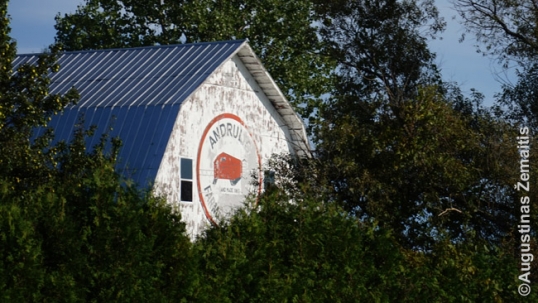
Andrulis cheese factory
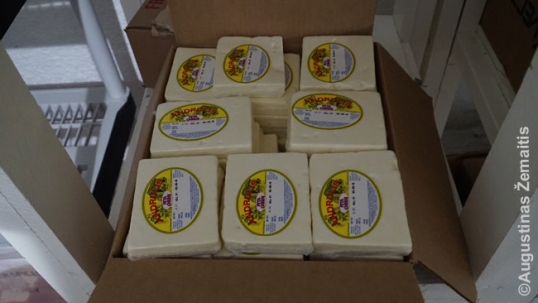
Andrulis cheese

Andrulis cheese factory interior
There are more Lithuanian descendants who farm. Lithuanian farming heritage is celebrated by Lithuanian quilt, a barn decorated by Lithuanian flag colors and Lithuanian symbol in Fountain village. The farm owners Budzynskis participated in the barn beautification project "Mason County Barn Quilt Trail" which led to some 11 barns being covered with such artworks, often relating to the area's heritage or goals. The sign near Budzynski farm indicates that it is held by the same family for 100+ years.
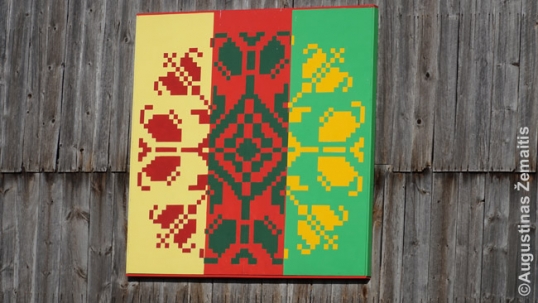
Lithuanian Quilt
Yet another farm that is held by the same family for 100+ years was even inscribed into the National Register of Historic Places, the most important US federal register of heritage where just a few Lithuanian heritage sites exists. That's the John and Katharine Tunkun Podjun Farm (original surnames: Tunkūnas and Puodžiūnas). In a story rather similar to that of many "New Lithuania" settlers, the farm's founder Jonas Puodžiūnas immigrated from Lithuania through the east coast (Boston) ~1898 to work in coal mines (Southern Illinois). There, he became disillusioned with the working conditions. Unlike some other Lithuanians, he did not drink alcohol and thus was able to save money. Therefore, when he saw Keledis's advertisements for farm land in Michigan in a Lithuanian-American newspaper, he took up the opportunity. He acquired what is now Tunkun Podjun farm in 1914, building its still-existing buildings such as the farm barn and farmhouse over the next 15 years. The authenticity of these buildings and their little change since 1910s-1920s was the reason why the Tunkun Podjun farm was inscribed in the NHRP. Like many male Lithuanian-Americans of the time, Puodžiūnas brought a wife for himself from Lithuania in 1904 - Kotryna Tunkūnaitė, together with whom he developed the farm. Also, like many Lithuanian-Americans of the era, their name got anglicized and shortened (Jonas Puodžiūnas > John Podjunus > John Podjun; Kotryna Tunkūnaitė > Katharine Tunkun). While the initial generation of immigrants had an endogamous marriage, later generations intermarried with other ethnicities of the area, however, they still remembered the roots. Tunkun-Podjun farm is located 45 minutes driving east of Custer near the village of Luther. This shows just how large the area of Lithuanian settlement was.
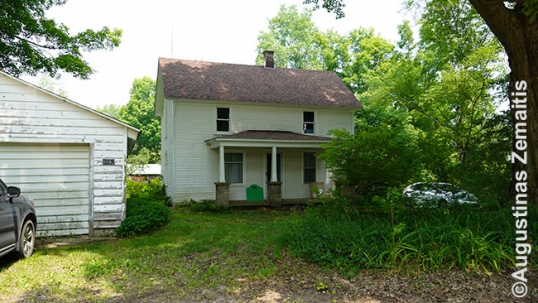
Tunkun-Podjun Farm main building

Tunkun-Podjun barn, built in the 1910s by Jonas Puodžiūnas
While name anglicizations make it not possible to see the true numbers of Lithuanian descendants still living in the area, there are still some people with original surnames. These surnames are visible in the names of the driveways, which in this area have official streetnames and are typically named after the owners. In 2023, for example, one may still find Brazas Road and Noreika Road on the area maps. However, as time passes and farms change hands, these names disappear.
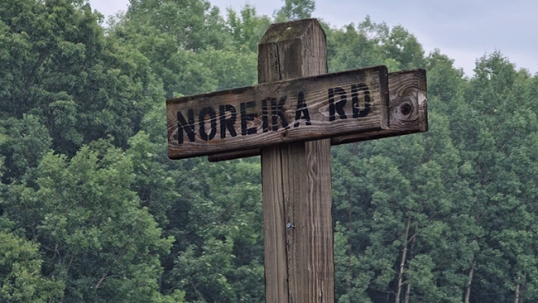
Noreika Road in Michigan
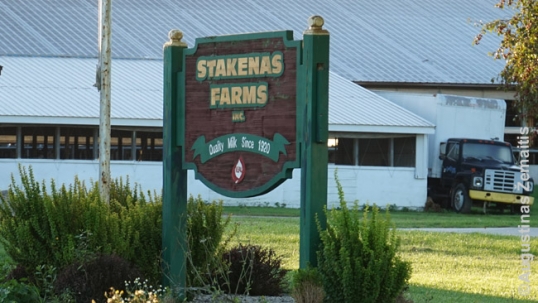
Stakenas Farms near Ludington
Another sign of any Lithuanina-heavy area are the traditional Lithuanian wayside crosses (a UNECO-inscribed immaterial world heritage). There is one near the Judis family farm, built by the owners to commemorate their trip to Lithuania in 1995, soon after the country became independent.
The area has no Lithuanian cemetery but Riverside Cemetery has many Lithuanian burials. There are also various other Lithuanian signs in the area.
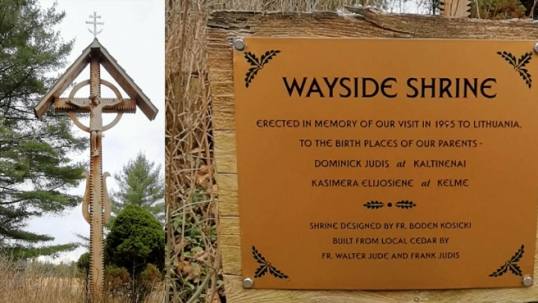
A roadside cross ner Irons, MI, built by Lithuanian owners of a nearby farm to commemorate their 1995 visit to Lithuania. Images by Linas Poniškaitis.
Rakas Lithuanian scout camp
The largest Lithuanian institution in the area is undoubtedly the Rakas Lithuanian scout camp, covering some 83 acres (33 ha) of a rather pristine forest (40 acres are used).
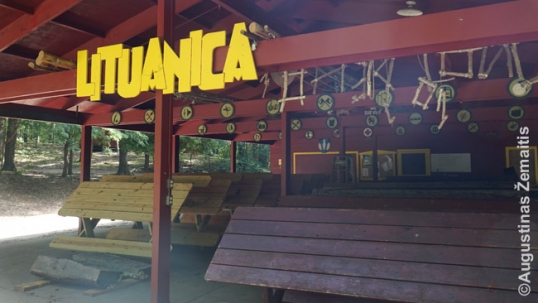
Lituanica building, one of the buildings of Camp Rakas sub-camps
Every summer, the camp holds the "main" 2-week long scout camp that draws some 250 scouts mainly from Chicago, as well as various smaller side-camps. In addition to the regular scouting ideals, the Lithuanian scouts of America also put a strong emphasis on the Lithuanian ethnic traditions: songs, dances, etc. The architecture of the camp is, therefore, very Lithuanian. There are multiple chapel-posts, each building is also covered in ethnic motifs.
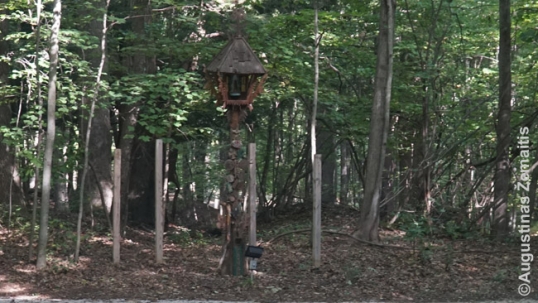
Larger chapel-post (koplytstulpis) of Camp Rakas
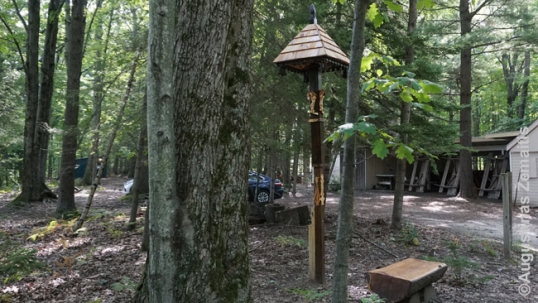
A small chapel-post (koplytstulpis) in Camp Rakas
The buildings are few and far between, however, as the scouts sleep in tents. The largest monument is near the entrance: it consists of a tower with a traditional scout symbol on top and 2018 renovation donors list nearby and on the bricks. There is also a memorial plaque that thanks Frank (Pranas) Rakas for the generous gift of land where Rakas now stands (actually, a 50 years lease paying 1 dollar a year; the land was bought out by the Chicago scouts afterward).
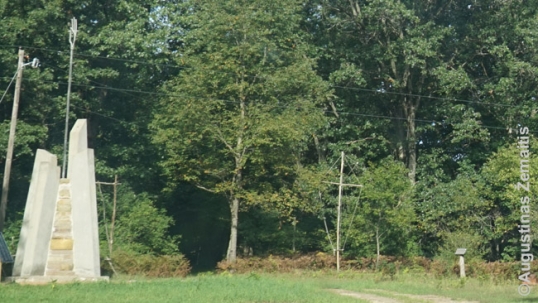
Camp Rakas main monument
The camp consists of four sub-camps, each with its own kitchen. All are named in Lithuanian: Kernavė (after Lithuania's first known capital, est. 1966), Lituanica (after the Darius and Girėnas plane they used to become the first Lithuanians to cross the Atlantic), Nerija (after the Curonian Spit), Aušros Vartai (after the gate of dawn in Vilnius Old Town). There are additional buildings, such as the first-aid post, each with ethnic details. Many of the original buildings were constructed in 1965-1975 but later repaired.
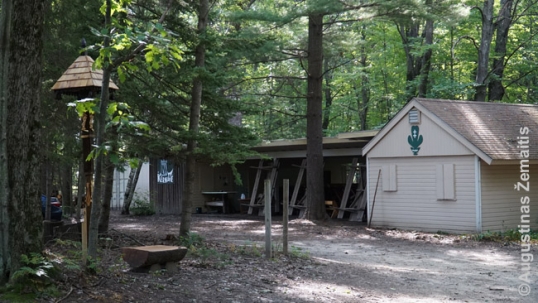
Kernavė sub-camp main building in camp Rakas
A Vyčiai square with ethnic decor is dedicated to the lifetime scouts.
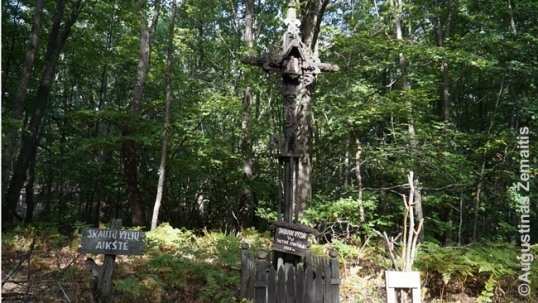
Vyčiai square in Camp Rakas
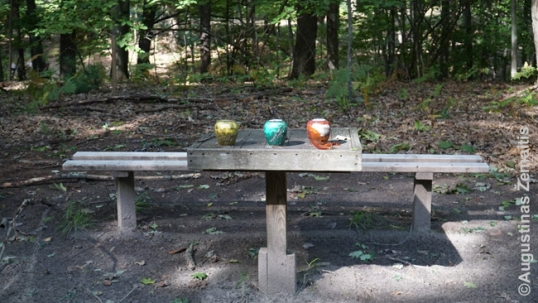
Lithuanian symbols at the Vyčiai square in Camp Rakas
The territory of the camp is usually locked outside of the season and cannot be visited. During the main camp, some 250 people participate, 66% kids and 33% adults. At one time, the numbers stood at 1000.
The map
All the Lithuanian locations, described in this article, are marked on this interactive map, made by the "Destination Lithuanian America" expedition (click the link):




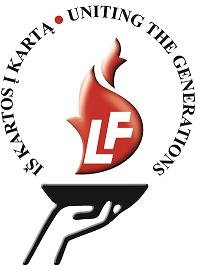

January 7th, 2019 - 16:17
Just wondering how many Lithuanians like my Grand Father were assigned an English last name not even close to the original spelling . The assign name was Willavage the Terrie name was. Ulavicz
January 7th, 2019 - 17:25
In our experience, very many / most Lithuanians had their names Anglicized in the first wave of Lithuanian Migration to the USA (~1865-1914). In later waves of migration, this was not common anymore.
It should be noted, however, that during the first wave there was still no standard orthography of the Lithuanian language, and even back in Lithuania (that was then ruled by the Russian Empire) Lithuanians often had to go by Russian or Polish versions of their names. The personal name at that time was much less of a truly personal thing in Eastern Europe, it being often changed (as it is spelt in the official documents) together with the changes of ruling powers or due to migration. Thus the anglicization of their names may not have seemed as weird to the immigrants of ~1900 as it would be to modern-day migrants.
Read here more about the history of Lithuanian language: http://www.truelithuania.com/lithuanian-language-863
Read here about the Polish/Lithuanian diglossia in pre-WW1 Lithuania: http://www.truelithuania.com/poles-134
Read here about the rule of the Russian Empire in Lithuania: http://www.truelithuania.com/the-rule-of-russian-empire-in-lithuania-1795-1918-254
September 1st, 2021 - 13:57
Is my last name Kava Americanised?
September 14th, 2021 - 00:36
Yes, most likely it is shortened.
November 25th, 2023 - 15:01
Wonderful webjourney through many camps, chapels, even a cheese factory. Fascinating
I appreciate your work so much
Recently I came upon another of Katharine Tunkun’s brothers. Michael who was a machinist in Boston. “Michael Tankunis aka Tankun and Tankuns was born in Stakiriu Birsiu Lithuania and immigrated to the USA on February 1896 via New York City. On February 12, 1899 he Married Dorothy (Dorothea) Pippin (Dorothy Pipinayczi Tankuns) in Boston Mass. They had 3 children: twins Mary and Anna (August 26 1900) and Olga (July 9 1911).” I have many websites where i found information on them. I would like to invite you to my Facebook page: Prestigious Podjun Progeny, could you have a look?
January 16th, 2024 - 02:12
Thank you for inviting us and showing us around the Tunkun-Podjun home, helping to add it as a heritage site to this encyclopedia!